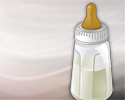Infant Formula - buying, preparing, storing, and feeding
Follow these tips for safely using infant formula.
- Buying, Preparing, and Storing Infant Formula
The following tips can help you buy, prepare, and store infant formula:
- Do not buy or use any formula in a dented, bulging, leaking, or rusty container. It may be unsafe.
- Store cans of powdered formula in a cool, dry place with a plastic lid on top.
- Do not use outdated formula.
- Always wash your hands and the top of the formula container before handling. Use a clean cup to measure the water.
- Make the formula as directed. Do not water it down or make it stronger than recommended. This can cause pain, poor growth, or rarely, more severe problems in your baby. Do not add sugar to formula.
- You can make enough formula to last for up to 24 hours.
- Once the formula is made, store it in the refrigerator in individual bottles or a pitcher with a closed lid. During the first month, your baby may need at least 8 bottles of formula per day.
- When you first buy bottles, boil them in a covered pan for 5 minutes. After that, you can clean bottles and nipples with soap and warm water. Use a special bottle and nipple brush to get at hard-to-reach places.
- Feeding Formula to Baby
Here is a guide to feeding your baby formula:
- You do not need to warm formula before feeding. You can feed your baby cool or room-temperature formula.
- If your baby prefers warm formula, warm it slowly by placing it in hot water. Do not boil the water and do not use a microwave. Always test the temperature on yourself before feeding your baby.
- Hold your child close to you and make eye contact while feeding. Hold the bottle so the nipple and the neck of the bottle are always filled with formula. This will help prevent your child from swallowing air.
- Throw away leftover formula within 1 hour after a feeding. Do not keep it and use again.
References
American Academy of Pediatrics website. Forms of baby formula: powder, concentrate & ready-to-feed. www.healthychildren.org/English/ages-stages/baby/formula-feeding/Pages/Forms-of-Baby-Formula.aspx. Updated May 9, 2022. Accessed February 13, 2024.
American Academy of Family Physicians website. Infant formula. familydoctor.org/infant-formula/. Updated September 21, 2022. Accessed May 25, 2023.
American Academy of Pediatrics website. Nutrition. www.healthychildren.org/English/ages-stages/baby/feeding-nutrition/Pages/default.aspx. Accessed May 25, 2023.
Parks EP, Shaikhkhalil A, Sainath NN, Mitchell JA, Brownell JN, Stallings VA. Feeding healthy infants, children, and adolescents. In: Kliegman RM, St. Geme JW, Blum NJ, Shah SS, Tasker RC, Wilson KM, eds. Nelson Textbook of Pediatrics. 21st ed. Philadelphia, PA: Elsevier; 2020:chap 56.



